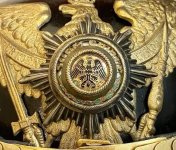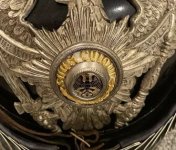Ok, I'll try to explain what I'm paying attention to

It could be very difficult to say whether a Guard Star is real or not. But the rings with the braided pattern are a first good indicator for me. I have seen these parts cast on reproductions only, such as this one from
www.Spikedhelmets.pl. The small cavities on the surface are clear signs of casting. Although a flawless finish can be achieved with a cast too, manufacturers of reproductions usually want to produce quickly and cost-effectively, which naturally has an impact on quality.
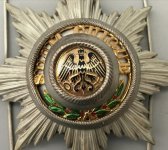 (Source: https://www.ebay.com/itm/275203967451)
(Source: https://www.ebay.com/itm/275203967451)
However, the text „SUUM CUIQUE“ and the eagle in the center of the example from Spikedhelmets.pl differ from the example recently discussed in another post:
That's why I also look at the hatched surface pattern on these letters too and how the letters were cut out. Back then, people were mostly proud of their own craftsmanship. So, if there was a hatched surface pattern (which not all Guard Stars had), this pattern was usually carefully crafted. The spacing between the lines should be similar, as well as the depth of the grooves.
In general, I always become cautious when I see castings that I otherwise only know have been pressed and the components are also of poor manufacturing quality.
Here are some close-ups of Guard Stars that are definitely original in my eyes:
Please note the frosted fire gilding on the 1st Guard Star, which is expensive to produce nowadays and never looks as beautiful when it is produced electroplated.
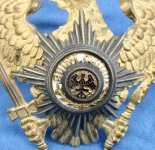
(posted by Brian L. years ago)
At first glance, the braided rings of this Guard Star seems to have small cavities too, but I think that these are not caused by the manufacturing process, but are impact dents.
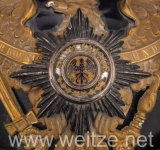 (Source: www.weitze.net)
(Source: www.weitze.net)
The last Guard Star is particularly beautifully crafted. Look at the sharp edges of the pressing and how cleanly the letters have been cut out. This really is a magnificent work

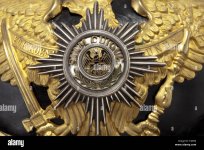
(Source: www.alamy.com; Image-ID: T4R3PJ)
There are certainly also authentic Guard Stars that were produced in a somewhat poorer manufacturing quality, but I think that these are more likely to be from wartime. The Guard regiments were elite troops and the officers were certainly very proud of their position. Furthermore, the helmets were expensive custom-made products, and customers were allowed to expect appropriate quality. I therefore doubt that helmets of poor quality were the rule.










